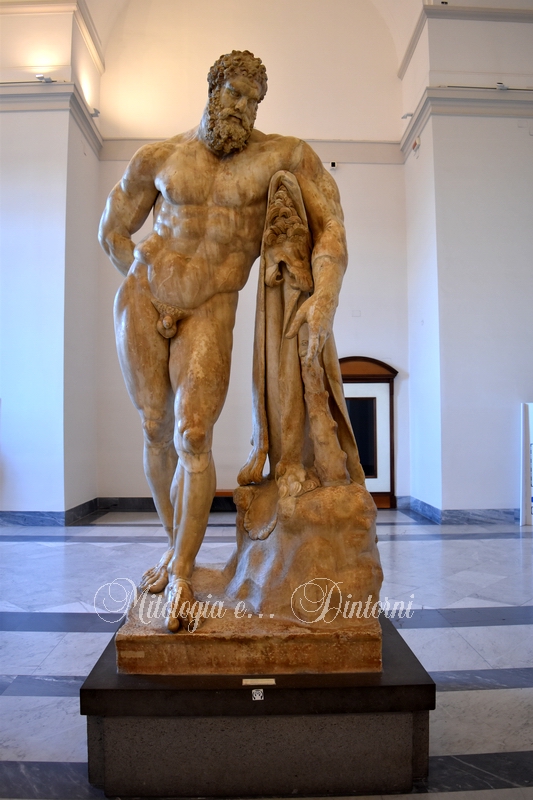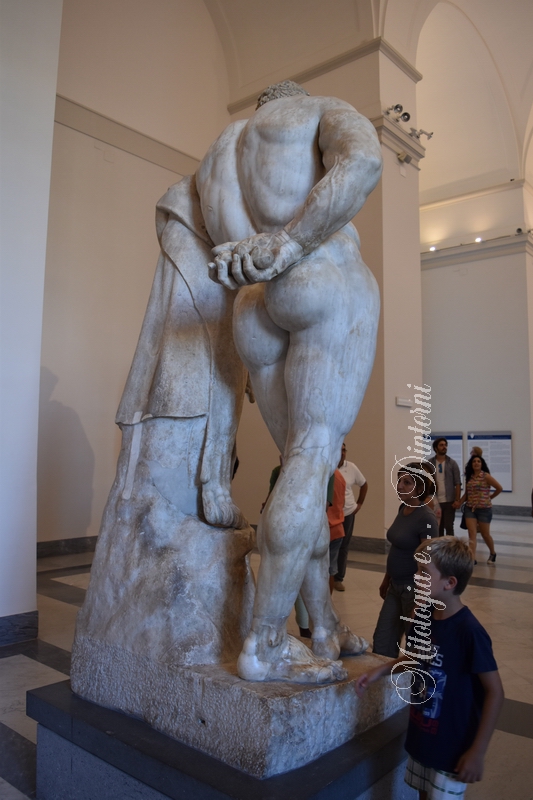Indice dei Musei
presenti in miti3000
Napoli Museo Nazionale - Piano Terra - Collezione Farnese - sala XI
Testo
Ercole in riposo
inv. 6001
Copia romana, fine II - inizi III secolo d.C., da originale greco della seconda metà del IV secolo a.C..
La statua riproduce una delle più famose edizioni del tema dell’Ercole in riposo. L’eroe appare stanco e pensoso dopo l’ennesima fatica impostagli dal cugino Euristeo. I frutti che stringe nella mano destra portata dietro la schiena lasciano intendere che si tratta della conquista dei pomi nel giardino delle Esperidi. La scena del mito è suggerita dalla roccia. L’eroe vi ha deposto la clava e la leontea, arrestandosi, mentre i piedi conservano ancora il movimento della marcia. Alla posa vigile delle gambe si oppone il rilassamento del busto, così sbilanciato a sinistra che la figura nella realtà non potrebbe reggersi. Questo schema iconografico arricchito di significativi dettagli è proprio di un tipo statuario, detto dai migliori esemplari “Farnese-Pitti”, che riproduce un originale bronzeo creato nella seconda metà del IV secolo a.C. da Lisippo o dalla sua bottega. Sul basamento roccioso è inciso il nome del copista Glykon ateniese che ha realizzato l’opera alla fine del II o agli inizi del III secolo d.C.
La statua fu rinvenuta, come documenta uno schizzo di Antonio da Sangallo, nel passaggio colonnato tra il frigidarium e l’ambiente a nord di esso o, secondo altri, il tepidarium, insieme ad una statua simile - il c.d. Ercole Latino - oggi alla Reggia di Caserta. Le due statue erano affiancate sotto il portico del cortile di Palazzo Farnese. L’opera è sostanzialmente antica, ad eccezione dell’avambraccio sinistro di gesso. Intorno all’Ercole, divenuto presto famosissimo, fiorirono numerose leggende, come quella che voleva la testa ritrovata in un pozzo a Trastevere.
Quando Ferdinando IV di Borbone decise di trasferire l’intera collezione a Napoli, polemiche particolarmente aspre si ebbero a proposito dell’Ercole, meta obbligata di viaggiatori ed artisti italiani e stranieri. Durante il trasporto, avvenuto nel 1787, la statua subì numerosi distacchi delle parti restaurate. Nelle more della creazione di una sala apposita all’interno del Museo, e per la riluttanza dei restauratori napoletani ad intervenire su un’opera così famosa, l’Ercole rimase per molti anni dentro una cassa. Solo sotto la direzione di Michele Arditi (1807-1839), falliti i progetti proposti, esso venne esposto nel sito che attualmente occupa. In questa stessa sala sono esposte le gambe realizzate da Guglielmo della Porta. Al momento del rinvenimento la statua risultò mutila e solo qualche tempo dopo furono trovati gli arti inferiori mancanti. Le gambe cinquecentesche, però, furono preferite alle originali e lasciate fino alla fine del ‘700, quando lo scultore Carlo Albacini reintegrò le parti antiche.
Hercules at rest
inv.6001
Roman copy, end 2nd-early 3rd centuries AD, from a Greek original of second half 4th century BC.
This statue reproduces one of the most famous versions depicting the theme of Hercules at rest. The hero appears exhausted and pensive after the umpteenth labour undertaken for his cousin Eurystheus. The fruit that he carries in his right hand, held behind his back, suggests Hercules’ acquisition of the apples from the Garden of the Hesperides. The rock hints at the setting for that particular mythological episode. The hero has put down his club and lion-skin and halted, although his feet still convey a sense of movement on his journey The dynamic pose of his legs is offset by the sagging of the head and shoulders, and the statue is so unbalanced towards the left that in reality the figure would be unable to stand up. The iconographic scheme employed here, elaborated with such significant detail, is that of a statue-type known as “Farnese-Pitti” on the basis of its finest examples. It reproduces a bronze original created by Lysippos or his workshop in the second half of the 4th century BC. Inscribed on the rocky base of this version is the name of the Athenian copyist Glykon, who produced this work at the end of the second or beginning of the 3nd century AD.
As documented in a sketch by Antonio da Sangallo, this statue was either discovered in the colonnaded passageway between the frigidarium and the room to the north of it, or (according to other sources) the tepidarium. It was found together with a similar statue, the so-called Latin Hercules, now in the Royal palace at Caserta. The two statues were set side by side in the portico of the court yard of the Palazzo Farnese.
The piece is, for the most part, authentically ancient, apart from the left forearm, restored in plaster.
For many years the Hercules was kept in a crate, due to delays in the construction of an appropriate room in the Museum and the reluctance of Neapolitan restorers to work on such a famous piece.
It was only when Michele Arditi was director of the Museum (1807-1839), and the projects that had been planned had fallen through, that the statue was put on display in its current location.
Also on display in this room are the legs produced by Guglielmo della Porta. When the statue was found, it was damaged, and its missing lower limbs were not found for some time. The 16th century legs were preferred to the originals, and were left in place until the end of 18th century, when the sculptor Carlo Albacini re-integrated the ancient components.
Clicca sulle varie parti dell'immagine per i particolari
 |
 |
Fotografie di Giorgio Manusakis
